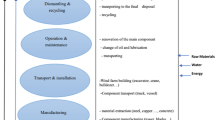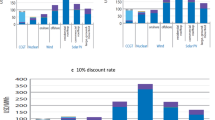Abstract
Wind turbine (WT) manufacturers are focusing on reducing the cost of energy produced by new models; however, the same consideration has not been given to their environmental consequences, nor the academic literature. For these reasons, the case study focuses on the environmental performance of the energy generated and distributed by the models launched from 2010 to 2018 by a world-leading manufacturer. It has been shown that, in relation to the year of release, the impacts per kWh of electricity generated and distributed increase on annual average in the four categories of environmental impact analysed: acidification potential, 11.3%; eutrophication potential, 34.5%; global warming potential, 7.8%; and photochemical ozone, 3.2%. The “Raw material acquisition and WT manufacturing” phase accounts for 49% to 74% of the global impacts generated, depending on the model and the category analysed. This is mainly due to energy consumption in the manufacturing of blades and consumption of electrical and electronic components in cabinets and converter. In the “Construction of wind farms” phase, impacts vary between 21 and 41%. Transport, steel and concrete in the foundations and metals in the transmission network are the most critical aspects. In the “Operation and Maintenance” phase, impacts vary between 3.5 and 27%, but it is the phase with the highest growth in impact, mainly due to the replacement of larger blades. Finally, the “End-of-Life” phase generates the lowest impact (between 0.3 and 4%). The research highlights the need to control the environmental impacts of all energy sources, including renewable energies.
Graphic abstract




Similar content being viewed by others
References
Alsaleh A, Sattler M (2019) Comprehensive life cycle assessment of large wind turbines in the US. Clean Technol Environ Policy 21:887–903
Arvesen A, Hertwich EG (2012) Assessing the life cycle environmental impacts of wind power: a review of present knowledge and research needs. Renew Sustain Energy Rev 16(8):5994–6006
Asdrubali F, Baldinelli G, D’Alessandro F, Scrucca F (2015) Life cycle assessment of electricity production from renewable energies: review and results harmonization. Renew Sustain Energy Rev 42:1113–1122
Atilgan B, Azapagic A (2016) Renewable electricity in Turkey: life cycle environmental impacts. Renew Energy 89:649–657
BNEF (2018) Global Wind Turbine Market Shares Bloomberg New Energy Finance, New York City
Bonou A, Laurent A, Olsen SI (2016) Life cycle assessment of onshore and offshore wind energy-from theory to application. Appl Energy 180:327–337
Caduff M, Huijbregts MA, Althaus HJ et al (2012) Wind power electricity: the bigger the turbine the greener the electricity? Environ Sci Technol 46(9):4725–4733
CEER (2017) Report on Power Losses Bruxelles. Council of European Energy Regulators, Brussels
CEN (2013) EN 15804:2012+A1:2013. Sustainability of construction works - Environmental product declarations - Core rules for the product category of construction products. European Committee for Standardization, Brussels
Chiang AC, Moore MR, Johnson JX, Keoleian GA (2016) Emissions reduction benefits of siting an offshore wind farm: a temporal and spatial analysis of Lake Michigan. Ecol Econ 130:263–276
Chipindula J, Botlaguduru V, Du H et al (2018) Life cycle environmental impact of onshore and offshore wind farms in Texas. Sustain 10(6):2022
Demir N, Taşkın A (2013) Life cycle assessment of wind turbines in Pınarbaşı-Kayseri. J Cleaner Prod 54:253–263
Dolan SL, Heath GA (2012) Life cycle greenhouse gas emissions of utility-scale wind power: systematic review and harmonization. J Ind Ecol 16:S136–S154
Greening B, Azapagic A (2013) Environmental impacts of micro-wind turbines and their potential to contribute to UK climate change targets. Energy 59:454–466
Guezuraga B, Zauner R, Pölz W (2012) Life cycle assessment of two different 2 MW class wind turbines. Renew Energy 37(1):37–44
GWEC (2019) Global Wind Report 2018. In: Global Wind Energy Brussels.http://www.gwec.net/global-figures/wind-energy-global-status/. Accessed: 23 Oct 2019
Harrell FE (2015) Ordinal logistic regression. Regression modeling strategies. Springer, Heidelberg, pp 311–325
Hauschild MZ, Goedkoop M, Guinée J et al (2013) Identifying best existing practice for characterization modeling in life cycle impact assessment. Int J Life Cycle Assess 18(3):683–697
Herrmann IT, Moltesen A (2015) Does it matter which Life Cycle Assessment (LCA) tool you choose? A comparative assessment of SimaPro and GaBi. J Cleaner Prod 86:163–169
Hertwich EG, Gibon T, Bouman EA et al (2015) Integrated life-cycle assessment of electricity-supply scenarios confirms global environmental benefit of low-carbon technologies. Proc Natl Acad Sci 112(20):6277–6282
IRENA (2019) Renewable Power Generation Costs in 2018. International Renewable Energy Agency, Abu Dhabi
ISO 14001 (2015) ISO 14001:2015 Environmental management systems. Requirements with guidance for use. International Organization for Standardization, Geneva
ISO 14025 (2006a) ISO 14025:2006 Environmental Labels and Declarations. Type III Environmental Declarations: Principles and Procedures. International Organization for Standardization, Geneva
ISO 14040 (2006b) ISO 14040:2006 Environmental management. Life cycle assessment. Principles and framework. International Organization for Standardization, Geneva
ISO 14044 (2006c) ISO 14044:2006 Environmental management. Life cycle assessment. Requirements and guidelines. International Organization for Standardization, Geneva
ISO 14064 (2006d) ISO 14064:2006 Greenhouse gases. International Organization for Standardization, Geneva
JRC-IEA (2010) International Reference Life Cycle Data System (ILCD) Handbook: General guide for Life Cycle Assessment, Detailed guidance, 1st edn. Publications Office of the European Union, Luxembourg
Kaldellis JK, Garakis K, Kapsali M (2012) Noise impact assessment on the basis of onsite acoustic noise immission measurements for a representative wind farm. Renew Energy 41:306–314
Klain SC, Satterfield T, Sinner J et al (2018) Bird killer industrial intruder or clean energy? Perceiving risks to ecosystem services due to an offshore wind farm. Ecol Econ 143:111–129
Ladenburg J, Termansen M, Hasler B (2013) Assessing acceptability of two onshore wind power development schemes: a test of viewshed effects and the cumulative effects of wind turbines. Energy 54:45–54
Landeta B, Arana G, Calvo PM, Heras I (2018) Wind energy and local communities: a manufacturer’s efforts to gain acceptance. Energy Policy 121:314–324
Leung DY, Yang Y (2012) Wind energy development and its environmental impact: a review. Renew Sustain Energy Rev 16(1):1031–1039
Liu P, Barlow CY (2017) Wind turbine blade waste in 2050. Waste Manag 62:229–240
Marques AT, Batalha H, Rodrigues S et al (2014) Understanding bird collisions at wind farms: an updated review on the causes and possible mitigation strategies. Biol Conserv 179:40–52
Martínez E, Latorre-Biel JI, Jiménez E et al (2018) Life cycle assessment of a wind farm repowering process. Renew Sustain Energy Rev 93:260–271
Maxwell JA, Chmiel M (2014) Notes toward a theory of qualitative data analysis. In: Flick U (ed) The SAGE handbook of qualitative data analysis. SAGE Publications Ltd, London, pp 21–34
May R, Gill AB, Köppel J et al (2017) Future research directions to reconcile wind turbine - wildlife interactions. In: Koppel J (ed) Wind Energy and Wildlife Interactions: presentations from the CWW2015 conference. Springer International Publishing, pp 255–276
McKinsey (2019) Global energy perspective: reference case 2019. McKinsey&Company, New York City. Available at: https://www.mckinsey.com/industries/oil-and-gas/our-insights/global-energy-perspective-2019
Mendecka B, Lombardi L (2019) Life cycle environmental impacts of wind energy technologies: a review of simplified models and harmonization of the results. Renew Sustain Energy Rev 111:462–480
Ozoemena M (2016) Sustainability Assessment of Wind Turbine Design Variations: An Analysis of the Current Situation and Potential Technology Improvement Opportunities. Ph.D. Dissertation Northumbria University Newcastle upon Tyne
Ozoemena M, Cheung WM, Hasan R (2018) Comparative LCA of technology improvement opportunities for a 1.5-MW wind turbine in the context of an onshore wind farm. Clean Technol Environ Policy 20:173–190
Ray P (2019) Renewable energy and sustainability. Clean Technol Environ Policy 21:1517–1533
Razdan P, Garrett P (2015) Life cycle assessment of electricity production from an onshore V100-2.0 MW Wind Plant. Vestas Wind Systems A/S
Schreiber A, Marx J, Zapp P (2019) Comparative life cycle assessment of electricity generation by different wind turbine types. J Cleaner Prod 233:561–572
Singh B, Strømman AH, Hertwich EG (2011) Comparative life cycle environmental assessment of CCS technologies. Int J Greenh Gas Control 5(4):911–921
Taylor M, Daniel K, Ilas A, So EY (2015) Renewable Power Generation Costs in 2014. International Renewable Energy Agency January
Wang S, Wang S (2015) Impacts of wind energy on environment: a review. Renew Sustain Energy Rev 49:437–443
Weisberg S (2005) Appl linear regression, vol 528. Wiley, New York
Wiser R, Jenni K, Seel J et al (2016) Expert elicitation survey on future wind energy costs. Nat Energy 1(10):16135
Xue B, Ma Z, Geng Y et al (2015) A life cycle co-benefits assessment of wind power in China. Renew Sustain Energy Rev 41:338–346
Yin RK (2017) Case study research and applications: Design and methods. Sage publications, Thousand Oaks
Funding
This paper is part of the work of the GIC IT1073-16 research group of the Basque University System Research Group funded by the Basque Government. There is no relationship whatsoever between the authors and the OEM, apart from the contacts strictly necessary to carry out the research. Neither the research group nor the University of the Basque Country, to which the authors belong, has directly or indirectly received funds from the OEM. The case study was conducted for purely academic purposes.
Author information
Authors and Affiliations
Contributions
All authors contributed to the study conception and design. Beñat Landeta-Manzano, Germán Arana-Landín, María Begoña Peña-Lang and Naiara Uriarte-Gallastegi carried out the preparation of material, data collection and analysis. The second draft of the manuscript was written and commented in previous versions of the manuscript by all authors. Likewise, all authors have read and approved the final manuscript.
Corresponding author
Ethics declarations
Conflict of interest
The authors declare no conflict of interest.
Additional information
Publisher's Note
Springer Nature remains neutral with regard to jurisdictional claims in published maps and institutional affiliations.
Rights and permissions
About this article
Cite this article
Arana-Landín, G., Landeta-Manzano, B., Peña-Lang, M.B. et al. Trend in environmental impact of the energy produced and distributed by wind power systems. Clean Techn Environ Policy 22, 1041–1054 (2020). https://doi.org/10.1007/s10098-020-01863-6
Received:
Accepted:
Published:
Issue Date:
DOI: https://doi.org/10.1007/s10098-020-01863-6




